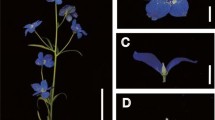Abstract.
The role of ethylene in the control of senescence of both petals and unpollinated carpels of pea was investigated. An increase in ethylene production accompanied senescence, and the inhibitors of ethylene action were effective in delaying senescence symptoms in different flower verticils. Pollination did not seem to trigger the senescence syndrome in the corolla as deduced from the observation that petals from pollinated and unpollinated flowers and from flowers whose carpels had been removed senesced at the same time. A cDNA clone encoding a putative ethylene-response sensor (psERS) was isolated from pea flowers, and the pattern of expression of its mRNA was studied during development and senescence of different flower tissues. The levels of psERS mRNA paralleled ethylene production (and also levels of 1-aminocyclopropane-1-carboxylic acid oxidase (ACO) mRNA) in both petals and styles. Silver thiosulfate treatments were efficient at preventing ACO and psERS mRNA induction in petals. However, the same inhibitor showed no ability to modify expression patterns in pea carpels around the anthesis stage, suggesting different controls for ethylene synthesis and sensitivity in different flower organs.
Similar content being viewed by others
Author information
Authors and Affiliations
Additional information
Received: 18 June 1998 / Accepted: 22 December 1998
Rights and permissions
About this article
Cite this article
Orzáez, D., Blay, R. & Granell, A. Programme of senescence in petals and carpels of Pisum sativum L. flowers and its control by ethylene. Planta 208, 220–226 (1999). https://doi.org/10.1007/s004250050553
Issue Date:
DOI: https://doi.org/10.1007/s004250050553




